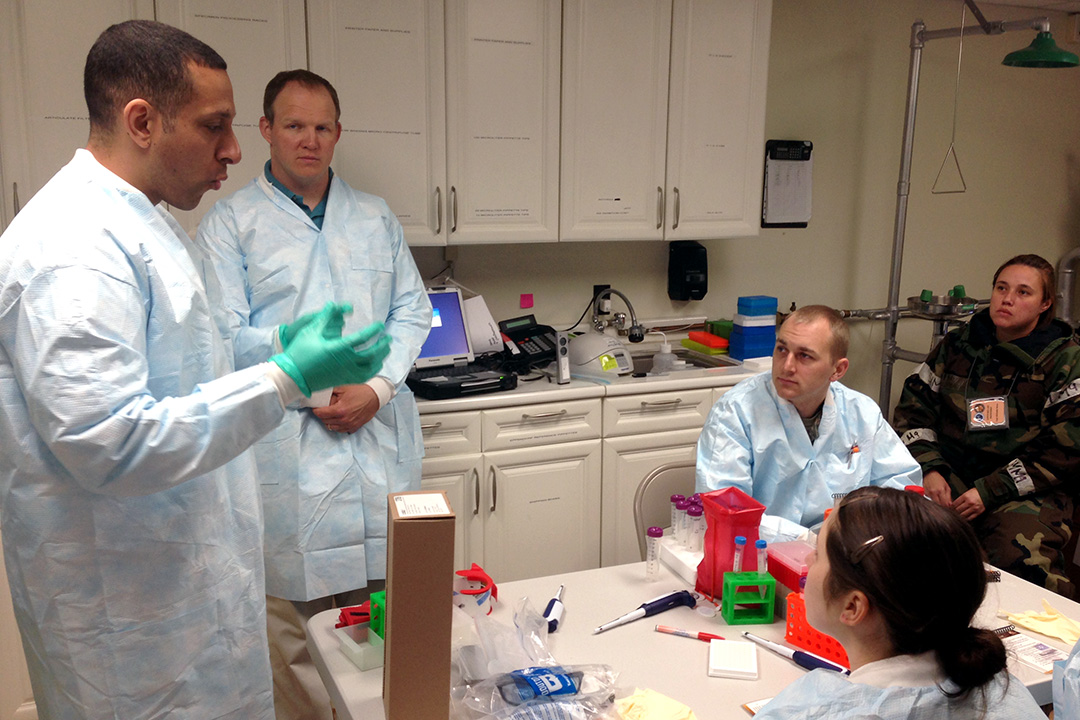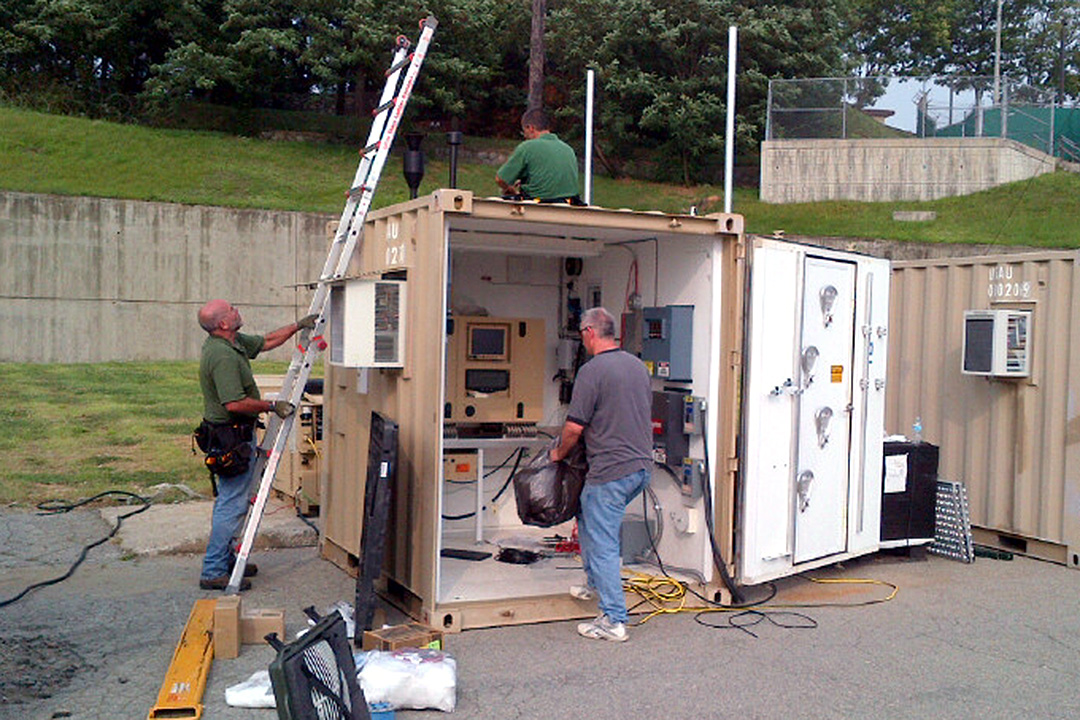// NEWS RELEASE
ECBC Experts Enhance Military Laboratory Capabilities
A team from ECBC led an effort to increase the ability of United States Forces Korea to analyze samples of suspected biological warfare agents.
CCDC Chemical Biological Center Public Affairs | April 15th, 2016
ECBC Experts Enhance Military Laboratory Capabilities
A team from ECBC led an effort to increase the ability of United States Forces Korea to analyze samples of suspected biological warfare agents.
DEVCOM CBC Public AffairsApril 15th, 2016

Scientists from ECBC partner with scientists from the United States Army Medical Research Institute of Infectious Diseases and the Naval Medical Research Center to get user feedback on upgraded biosurveillance laboratory equipment ECBC installed in laboratories in South Korea and Japan as part of Project JUPITR’s BICS Leg.
A multidisciplinary team of researchers and technicians from the U.S. Army Edgewood Chemical Biological Center (ECBC) has led the effort to upgrade laboratory capabilities a half a world away, dramatically increasing the ability of United States Forces Korea (USFK) to analyze samples of suspected biological warfare agents.
In just four months, ECBC increased the sample throughput of three U.S. military laboratories in South Korea from two to three samples of suspected biological warfare agent per day to dozens per day with a 24-hour turn-around time for results.
The laboratory upgrades were part of a larger project known as the Joint USFK Portal and Integrated Threat Recognition (JUPITR) Advanced Technology Demonstration. Funding and strategic guidance comes from the U.S. Department of Defense Joint Program Executive Office for Chemical and Biological Defense. The project is being managed and executed by ECBC.
“We did a complete make-over of two existing Air Force labs and set up an Army lab from scratch,” said Brady Redmond, Ph.D., the laboratory project lead. “We upgraded the Air Force labs’ analytical technology and equipment, and we set up filters to protect the laboratory buildings from chemical biological threats. We placed all new equipment in the Army laboratory, and we got all three laboratories to start talking to each other, sharing supplies and sharing lessons learned.”
The Most Advanced Analytics in the World
The Army laboratory is located at Yongsan Army Garrison in Seoul. The Air Force laboratories are located at Osan Air Base and Kunsan Air Base, both on the west coast of the Republic of Korea. ECBC is setting up a fourth laboratory at Camp Humphreys for the U.S. Army Public Health Command which it expects to complete in the next year. These laboratories provide USFK and the Republic of Korea with the most advanced analytics the world – proteomics, genomic sequencing, plus nucleic acid and antibody-based identifiers. Taken together, these laboratories form a bulwark of detection and protection from biological warfare as well as naturally occurring threats such as bird flu or SARS.
The laboratory upgrades are just one aspect of the JUPITR ATD, which consists of four capability areas, referred to as legs. An Early Warning Leg provides an early alert to threatening activities using sensors and cameras. An Assessment of Early Detection Leg collects biological samples and performs a preliminary analysis. Redmond and his team are members of the Biological Identification Capability Sets, or BICS, Leg which uses advanced laboratory analytics to provide confirmatory analysis and precise identification of the type of biological agent. The fourth leg is the Global Biosurveillance Portal which is a web-based information platform shared by healthcare agencies around the world.
Choosing the Right Technology for the End Users
The selection of analytical methods was a crucial component of the BICS Leg. Not only did these methods have to meet very precise Department of Defense standards, they had to be readily usable by the U.S. military personnel staffing the laboratories. Depending on the location, they vary from U.S. Air Force Biological Augmentation Teams, to U.S. Army Public Health Command scientists, to U.S. Army laboratory officers.
“We performed an exhaustive study of the pros and cons of each available laboratory technology, then selected the ones that we believed would best meet the demands we had for them,” said Janet Betters, an ECBC microbiologist and BICS lab lead. “Then we got first-hand user feedback by having the actual users at each of these laboratory locations try them out.” Following the technology selections, the ECBC team developed protocols for each piece of equipment and trained the laboratory personnel to operate them.
While the end users are varied and each laboratory has a separate command and logistics structure, they all have one thing in common — the personnel rotate in and out of these laboratories every one to three years. “Like a garden, these laboratories need to be tended. We go over to Korea to visit our USFK partners frequently,” said Redmond. “We make sure that they are operating at a high-level working order, and we make sure they are well supplied. Currently, we are working with the labs to build stronger relationships between them. Sharing their knowledge and resources will only improve their operational readiness.”
A Model for the Region
From across the sea in Japan, the U.S. Army Public Health Command Region Pacific saw the importance of the biological surveillance capability being developed in Korea. They, in turn, worked with ECBC to upgrade an existing laboratory at Camp Zama outside Tokyo, modeling it on the laboratory ECBC is currently setting up at Camp Humphreys. Once completed, both laboratories will be operated by U.S. Army Public Health Command personnel. This redundancy has strategic importance; the laboratory in Japan can serve as a backup should armed conflict on the Korean Peninsula require it.
“The capabilities we are currently providing are just a starting point. The participants in the project are already looking to add a Zika virus detection capability in Yongsan,” said Redmond. “They can all be upgraded to detect any number of other naturally occurring biological threats.”
“This team established the model for the entire region,” said Peter Emanuel, Ph.D., the Project JUPITR lead and ECBC Biosciences Division chief. “The Republic of Korea didn’t just get a material solution for their biosurveillance needs in the form of laboratory equipment and a supply chain. They learned a whole new way of addressing their biosurveillance needs. They received the non-material benefits of technical integration and a network of professional relationships. The day will come when no one will be able to imagine what the Republic of Korea’s bio-defense was like before these upgrades.”
The U.S. Army Combat Capabilities Development Command (DEVCOM) leads in the discovery, development and delivery of technology-based capabilities to enable Soldiers to win our nation’s wars and come home safely. DEVCOM is a major subordinate command of the U.S. Army Futures Command. The DEVCOM Chemical Biological Center is the Army’s principal research and development center for chemical and biological defense technology, engineering and field operations. The DEVCOM Chemical Biological Center is headquartered at Aberdeen Proving Ground, Maryland.

